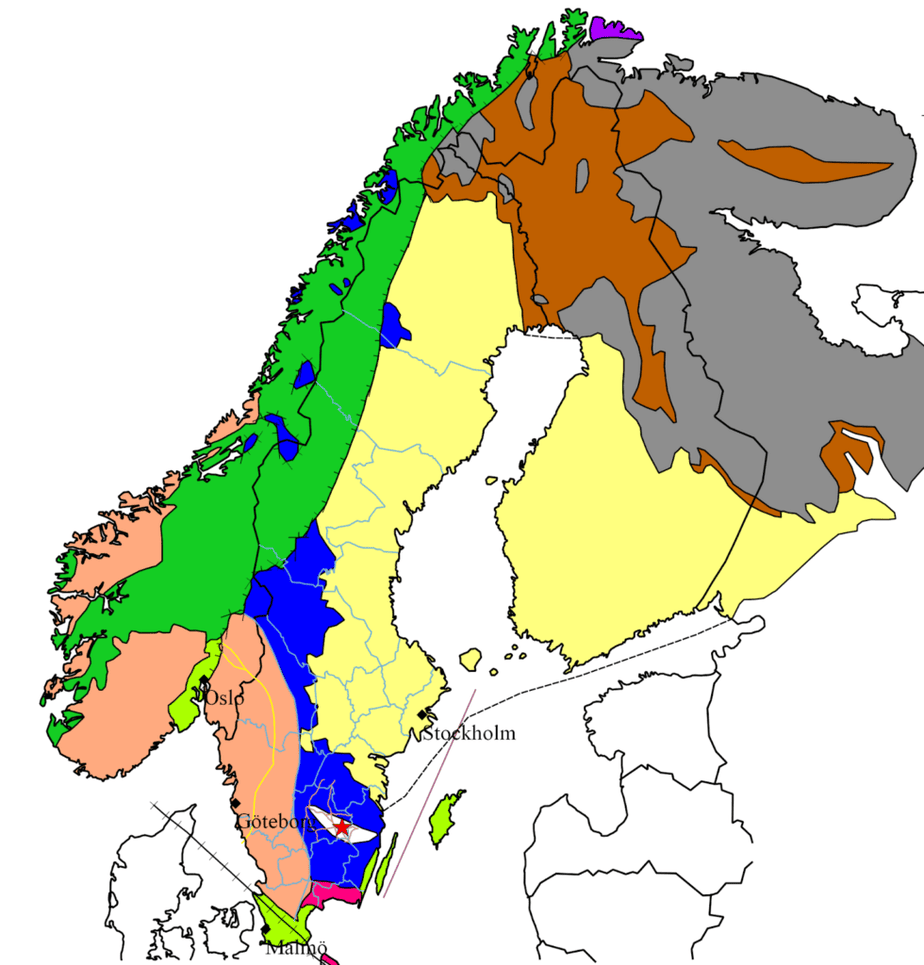A landmass is simply a large unbroken land area. Our planet is made of several land masses. The continents are considered unique pieces of landmass. These continents looked a lot different billions of years ago. Over Earth’s 4,54 billion history, the crust has shifted, land has rifted apart, mountains have risen, and supercontinents have formed and broken up because of plate tectonics.
Some of the oldest rocks on Earth likely formed around 4.4 billion years ago; most of this crust has either eroded over time or is buried well below the surface. Only small portions of ancient crust are still seen in some stable regions that have remained undisturbed for eons! Why is this relevant? Well, these remains give us clues into our planet’s past configurations and the history of the planet’s land masses.
So, let’s look at the 5 of the oldest landmasses in the world:
5. Baltic Shield
Age: Between 2.5 to 3.1 billion years old
Region: Fennoscandia, northwest Russia, Baltic Sea
Continent: Europe

The Baltic Shield is a segment of the East European Craton. It represents parts of Fennoscandia, northwest Russia, and the Baltic Sea. The Baltic Shield contains some of the oldest rocks of the European continent, with a thickness of 250 to 300 km. This landmass is divided into 5 provinces, with the Karelian, Belomorian, and Kola provinces containing the oldest rocks at 2.5 – 3.1 billion years old.
The Baltic Shield is thought to have been a part of an ancient continent and grew in size from collisions with nearby crustal fragments over a time of billions of years. The mountains created by the collisions have since eroded, becoming the flat region we see today.
Did you know?
When the Pleistocene glaciations repeatedly happened, it scraped a lot of sediments away. This now exposes broad strips of the ancient shield.
4. Western Australia
Age: Yilgarn and Pilbara cratons over 3 billion years old
Region: Western Australia
Continent: Australia

Western Australia consists of the really old Yilgarn carton and Pilbara carton, which are over 3 billion years old. This area holds the evidence of some of the earliest known life on land. The evidence is from around 3,48 billion years ago and was found in the Pilbara carton.
The land is very much eroded and literally ancient, with no points above 1249 meters, forming a low plateau due to very little mountain-building activity. The landscape is ancient because the soil is extremely infertile and often laterised.
The Yilgarn and Pilbara cratons merged billions of years ago with parts of India, Madagascar, and Southern Africa to form the supercontinent Ur. Moreover, the granite bedrock in the region is over 3 billion years old! Certain flora and fauna have evolved in isolation here, and this shows how old the landmass is because some of these flora and fauna can only be found here.
Did you know?
Because of the preserved geology in the continental fragments of Western Australia, it is easier to find out more about supercontinent cycles that are billions of years old.
3. Southern Africa
Age: Bushveld basin deposits over 2 billion years old; rock strata over 3 billion years old
Region: Southern Africa, including South Africa
Continent: Africa

Southern Africa: a landmass that incorporates geology from the assembly and breakup of supercontinents over billions of years. The Bushveld basin in South Africa holds mineral deposits of over 2 billion years! Rock strata in several areas here date back over 3 billion years when the early crust formed.
As landmasses shifted, the flora and fauna and diverse climate evolved in isolation over eons, and this is proof of how old the landmass is. The huge mineral deposits make it one of the most potentially economically valuable regions of Africa; on top of all that, the diamond mining in Botswana and Namibia is also proof of the really old age of the landmass.
Did you know?
This South African region has some of the earliest evidence of modern human origins, dating back 350,000-260,000 years ago.
2. South China
Age: Kongling Complex rocks 3.3 – 2.9 billion years old
Region: South China, divided into the Yangtze Block and the Cathaysia Block
Continent: Asia

The South China Craton is one of the largest Precambrian continental blocks of China. It is also one of the oldest. The oldest rocks here are found to be in the Kongling Complex, dating back 3.3 – 2.9 billion years. It is divided into the Yangtze Block and Cathaysia Block, separated by the Jiangshan – Shaoxing Fault boundary.
South China was part of the ancient supercontinent Rodinia. Thus, the geology of this landmass provides clues to past configurations. South China preserves traces of many different supercontinent cycles across over 3 billion years.
Did you know?
South China has fossil records of extinct marine reptiles from the Triassic period which is over 200 million years ago. Fossils of ichthyosaurs, sauropterygians, and thalattosaurs have been found in the sedimentary rocks of this region.
1. Canadian Shield
Age: Approximately 4.28 billion years old
Region: Eastern, northeastern, and east-central Canada, parts of the upper Midwest United States
Continent: North America

Simply, one of the oldest landmasses in the world. The Canadian Shield is a broad region of Precambrian rock that surrounds many regions, including the eastern, northeastern, and east central Canada and parts of the upper midwest United States. The age of this humongous rock is calculated to be 4.28 billion years old.
Once, the Canadian Shield was an area of very high mountains. But millions of years of erosion had very noticeable results. Now, it is just rolling hills with the roots of the ancient mountains exposed.
This Canadian Shield is quite long! It stretches over 8 million square kilometers, covering over half of Canada and parts of the United States. Some regions here have been dated between 2.5 – 4.2 billion years old. That’s like the great grandma of landmasses!!
Did you know?
A ton of rivers and lakes can be found here, and it is proof of past glacial activity disturbing the area’s drainage system. These rivers include the Churchill River, Nelson River, and the Winnipeg River.
Conclusion
Some of the oldest Continental crust dates back to over 4 billion years ago. This crust probably formed soon after Earth itself coalesced, survived a massive impact that formed the moon, and predates the first life on the planet! Over the years, this crust has fused and rifted apart from the constantly changing landmasses.
The mentioned oldest landmasses of the world contain this oldest continental crust. When we think about it, the world has existed long before us and even our greatest grandparents and will probably be here long after that. Maybe in a million years, our continents may be considered some of the oldest, or even our continents could be entirely different by then!
Happy aging!











